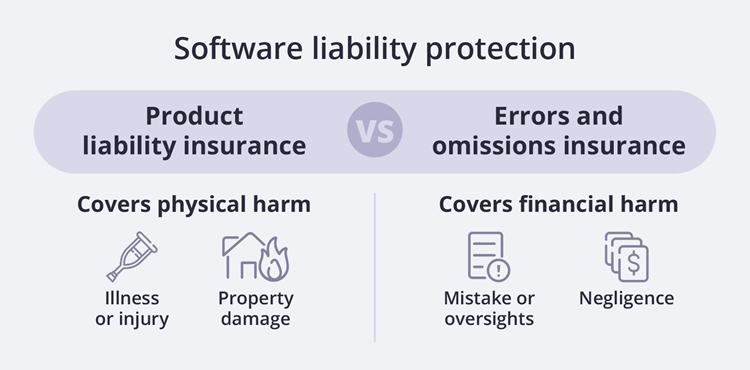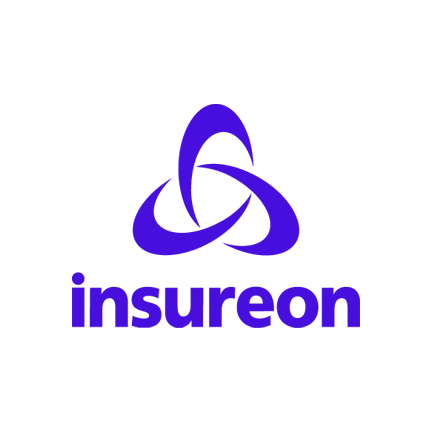What you need to know about software liability

When so many aspects of business rely on software, you want to avoid risks at all costs. Software failure can cause downtime, data loss, and numerous other problems that could negatively impact a client and lead to a lawsuit against your business.
That's why software developers and other IT professionals need to understand the basics of software liability, and how to protect your business if the software you provide is defective or causes unexpected issues.
Why a software defect could mean trouble for your small business
Anyone who recommends software to clients or works as a developer should consider:
- How could a software flaw affect my client?
- Could I be sued for a software defect?
- Would technology business insurance reduce my risks?
The risk is real: You can be sued for damages if your application crashes and causes financial harm. Though it's less likely to occur, you could also be held liable for property damage and physical injuries caused by software defects.
Fortunately, errors and omissions insurance (E&O) can help pay for legal costs when a client blames your software for financial harm. If a problem with your software could lead to property damage or physical injuries, you might want to invest in product liability insurance as well.

Current software liability laws
Software development is similar to other professional services when it comes to errors and omissions coverage. If someone can prove that your work caused financial harm, they will likely be compensated for their damages in court.
For someone to successfully sue a software developer for negligence, they must prove that:
- The software vendor had a duty to provide functioning software to the user
- The software did not perform as promised
- The user suffered harm
- The software caused that harm
These criteria apply when there’s no contract between the developer and client, according to standard tort law.
The importance of software licenses
Most software vendors use contracts or end user license agreements to define the terms of the relationship.
It’s becoming quite common for these contracts to include language that limits a software developer’s liability, even if the software doesn’t work. Courts have typically upheld these contracts and limited the liability of the software company.
By including a limitation of liability clause in your contract or end-user license agreement (EULA), it could curb or even eliminate your liability if you’re sued for a software defect.
If someone can prove that your work caused financial harm, they will likely be compensated for their damages in court.
When software causes physical harm
A strong license agreement between the user and software developer can greatly reduce your liability. But you could still be held liable for a software problem that causes a physical injury or property damage.
For example, a software development company is hired to write code that controls a corporation's electronic gates via smartphones. A developer runs a test that forces the gate to close unexpectedly, causing damage to an employee's car.
In this case, the software development business and the gate manufacturer might both be liable for damages to the injured party.
Quality control is key to preventing software-related injury
You can never be too careful when your customer’s safety is involved. You should test your products extensively to make sure you eliminate any potentially harmful bugs.
Pushing a software product before you’ve put it through enough quality control testing could have devastating consequences, as it did with the Therac 25 radiation therapy machine in the 1980s. In that case, software engineering errors led to deaths from massive overdoses of radiation.
Though software developers enjoy a larger degree of protection than medical device companies, contracts and license agreements may not always shield you from personal injury and tort claims. Sometimes complex circumstances can leave you vulnerable.
For example, 3D printing uses software and hardware to create a physical product. If a software defect caused the 3D printer to produce a flawed product that physically injured someone, the developer could face a lawsuit.

Large companies found liable for major software failures
Software defects can be disastrous, leading to costly settlements or court-ordered judgments. These examples show how faulty code can lead to disasters for companies and their customers.
Toyota Prius
In late 2018, Toyota recalled nearly 2.5 million Prius vehicles after finding a software glitch that could cause the cars to stall at high speeds. Four years earlier, the company recalled 1 million cars because of a similar bug.
Toyota’s alleged failure to properly patch the software generated several lawsuits.
In 2019, a jury ordered the company to pay $15.8 million in damages to a California car dealer who claimed Prius safety concerns caused his business to lose profits.
Boeing 737 MAX
The Federal Aviation Administration points to software defects as the root of two fatal Boeing 737 MAX airplane crashes due to automatic control system malfunctions.
According to Reuters, hundreds of lawsuits have been filed against Boeing by families of the victims of the October 2018 Lion Air crash in Indonesia and the March 2019 Ethiopian Air disaster.
The company settled the first lawsuits in the fall of 2019 and is expected to be held liable for more wrongful death claims.
Fortune reports that Boeing shareholders are currently suing the company’s directors for negligence when rushing the aircraft to market. Boeing has since grounded all 737 MAX aircrafts, which led to a January 2020 settlement with American Airlines.
Tesla Model S and Model X
In May 2020, a class action lawsuit was filed against Tesla over a failing touch screen that operates safety-related systems, including critical gauges and warning notifications whose failure could put drivers at risk of harm.
The company refunded some owners repair costs and expanded its warranty to cover the memory device failure that led to the touchscreen issues. In January 2021, the company recalled 135,000 vehicles in response to a National Highway Traffic Safety Administration (NHTSA) request.
How to protect your business with software liability insurance
Defective software can have serious implications for businesses of any size. For that reason, software developers typically carry these insurance policies:
Errors and omissions insurance
Errors and omissions insurance (E&O), also known as professional liability insurance, covers lawsuits related to the quality of your software and your work performance. It's perhaps the single most important policy for software developers and other IT professionals.
This policy can pay legal costs related to:
- Errors and oversights
- Breach of contract
- Incomplete work
- Undelivered services
- Missed deadlines
- Negligence
- Budget overruns
Businesses hired to develop white-label or custom applications for a product, hardware, or software manufacturer may be required to carry this coverage. If a client files a lawsuit, it will help pay for legal defense costs, settlements, court-ordered judgments, and other related expenses.
Cyber liability insurance
Cyber liability insurance protects your business from the high costs of a data breach or cyberattack. It can help your business pay for customer notification costs, fraud monitoring services, and other recovery expenses.
Most software developers choose to purchase technology errors and omissions insurance (tech E&O). This policy bundles E&O insurance and cyber liability insurance at a discount. It also covers legal costs in the event that your company is blamed for failing to prevent a data breach or cyberattack at a client's business.
Keep in mind, limits and exclusions vary from policy to policy. Talk with your insurance agent about what your policies cover and if you need to add a rider to protect against a specific event.
You might also want to consult an insurance attorney before deciding on a policy. Since technology evolves quickly, legal advice could be key to understanding how your business could be held liable and how you can take steps to protect it.

Other important policies to consider
While tech E&O covers the most important risks faced by software developers, you should consider other policies for tech professionals that protect against the common risks of running a small business.
For example, general liability insurance is usually the first policy purchased by small business owners. It protects against claims of bodily injuries and property damage to a third party, along with advertising injuries like libel or slander. It sometimes includes product liability insurance; check with an agent to make sure you're covered.
If you want protection for your business property or electronics, you can bundle general liability coverage with commercial property insurance in a business owner's policy for a discount.
You may also need workers' compensation insurance or commercial auto insurance depending on whether you have employees or a business vehicle.
The right coverage can protect your business against costly accidents and lawsuits, and helps you fulfill the requirements of state laws, client contracts, and commercial leases.
Compare insurance quotes from trusted providers with Insureon
Complete Insureon’s easy online application today to compare quotes for business insurance from top-rated U.S. carriers. Once you find the right policy for your small business, you can begin coverage in less than 24 hours.
Hannah Filmore-Patrick, Contributing Writer
Hannah is a contributing writer with a diverse writing and content building background. She's worked on topics from technology to insurance. She's competent with both language and SEO, and continues to work with a variety of business verticals to create engaging, optimized content.







